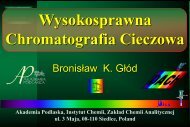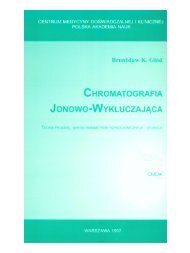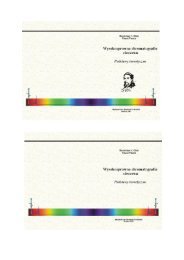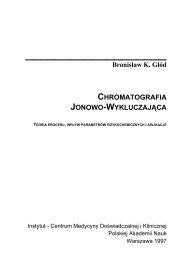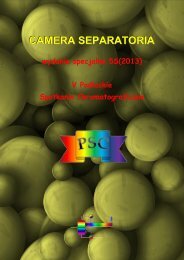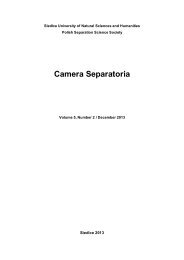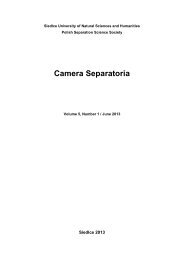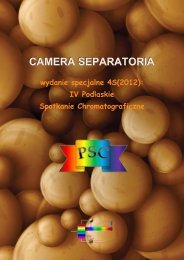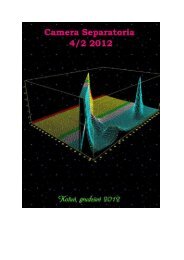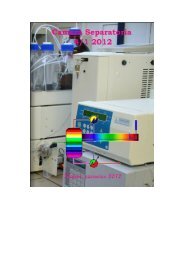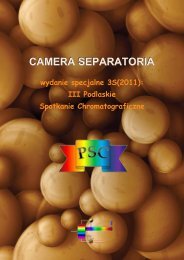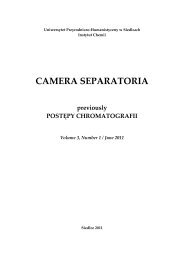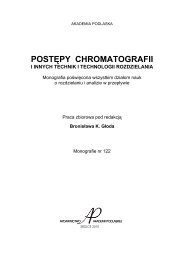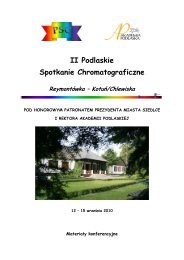CamSep 3 2
Create successful ePaper yourself
Turn your PDF publications into a flip-book with our unique Google optimized e-Paper software.
268<br />
A. Skrzypczak, M. Jaszczołt, A. Królicka, M. Kamiński<br />
2. P.P. Mebe, G.A. Cordell, J.M. Pezzuto, Pentacyclic triterpenes and naphtoquinones<br />
from Euclea divinorium, Phytochemistry, 47(1998)311.<br />
3. A. Wube, B. Streit, S. Gibbons, K. Asres, F. Bucar, In vitro 12(S)-HETE<br />
inhibitory activities of naphthoquinones isolated from the root bark of<br />
Euclea racemosa ssp. Schimperi, J. Ethnopharmacol., 102(2005)191.<br />
4. G. Bringmann, D. Feineis, Stress-related polyketide metabolism of<br />
Dioncophyllaceae and Ancistrocladaceae, J. Exp. Bot., 52(2001)2015.<br />
5. K.C.G. De Moura, F.S. Emerya, C. Neves-Pintoa, Pinto MCFR, Dantas<br />
AP, Salomão K, Castro S.L., Pinto A.V., Trypanocidal Activity of Isolated<br />
Naphthoquinones from Tabebuia and Some Heterocyclic Derivatives:<br />
A Review from an Interdisciplinary Study, J. Braz. Chem. Soc.,<br />
12(2001)325.<br />
6. S. Kohlmünzer, „Farmakognozja. Podręcznik dla studentów farmacji.”<br />
Wydawnictwo Lekarskie PZWL, Warszawa 2003.<br />
7. M.M. Cowan, Plant Products as Antimicrobial Agents, Clin. Microbiol.,<br />
12(1999)564.<br />
8. T. Tokunaga, N. Takada, M. Ueda, Mechanism of antifeedant activity of<br />
plumbagin, a compound concerning the chemical defense in carnivorous<br />
plant, Tetrahedron Lett., 45(2004)7115.<br />
9. T.P. Cushnie, A.J. Lamb, Antimicrobial activity of flavonoids, J. Antimicrob.<br />
Agents., 26(2005)343.<br />
10. E. Jr. Middleton, C. Kandaswami, T.C. Theoharides, The effects of plant<br />
flavonoids on mammalian cells: implications for inflammation, heart disease,<br />
and cancer, Pharmacol. Rev., 52(2000)673.<br />
11. P.G. Pietta, Flavonoids as Antioxidants, J. Nat. Prod., 63(2000)1035.<br />
12. Z. Zhu, C. Li, N.Q. Li, Electrochemical studies of quercetin interacting<br />
with DNA, Microchem. J., 71(2002)57<br />
13. Z. Jerzmanowska, Substancje roślinne. Metody wyodrębniania, PWN,<br />
Warszawa 1970.<br />
14. N. Didry, L. Dubreuil, F. Trotin, M. Pinkas, Antimicrobial activity of aerial<br />
parts of Drosera peltata Smith on oral bacteria, J. Ethnopharmacol.,<br />
60(1998)91.<br />
15. T. Sreelatha, A. Hymavathi, J. Madhusudhana Murthy, P.U. Rani,<br />
J. Madhusudana Rao, K. Suresh Babu, A new benzil derivative from<br />
Derris scandens: Structure-insecticidal activity study, Bioorg. Med.<br />
Chem. Lett., 20(2010)549.<br />
16. J.J. Marion-Meyer, F. Kooy, A. Joubert, Identification of plumbagin<br />
epoxide as a germination inhibitory compound through a rapid bioassay<br />
on TLC, S. Afr. J. Bot., 73(2007)654.<br />
17. A. Wube, B. Streit, S. Gibbson, K. Ares, F. Bucar, In vitro 12(S)-HETE<br />
inhibitory activities of naphthoquinones isolated from the root bark of<br />
Euclea racemosa ssp. Schimperi, J. Ethnopharm., 38(2005)325.<br />
18. J. Budzianowski, Naphtohydroquinone glucosides of Drosera rotundifolia<br />
and D. intermedia from in vitro cultures, Phytochem., 44(1996)1145.<br />
19. M. Sannomiya et al., Flavonoids and antiulcerogenic activity from<br />
Byrsonima crassa leaves extracts, J. Ethnopharmacol., 97(2005)1.<br />
Camera Separatoria Vol. 3, No 2/2011




